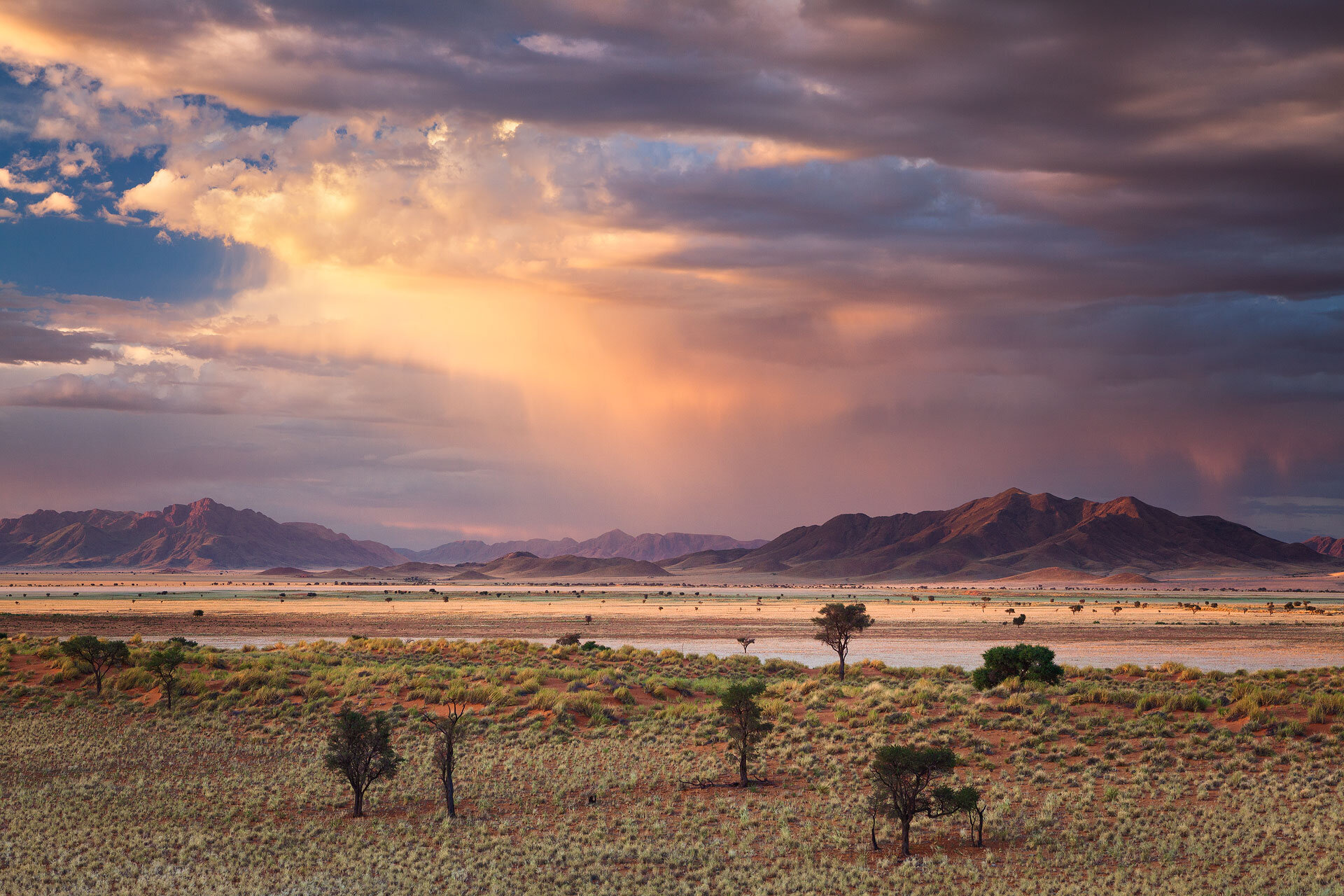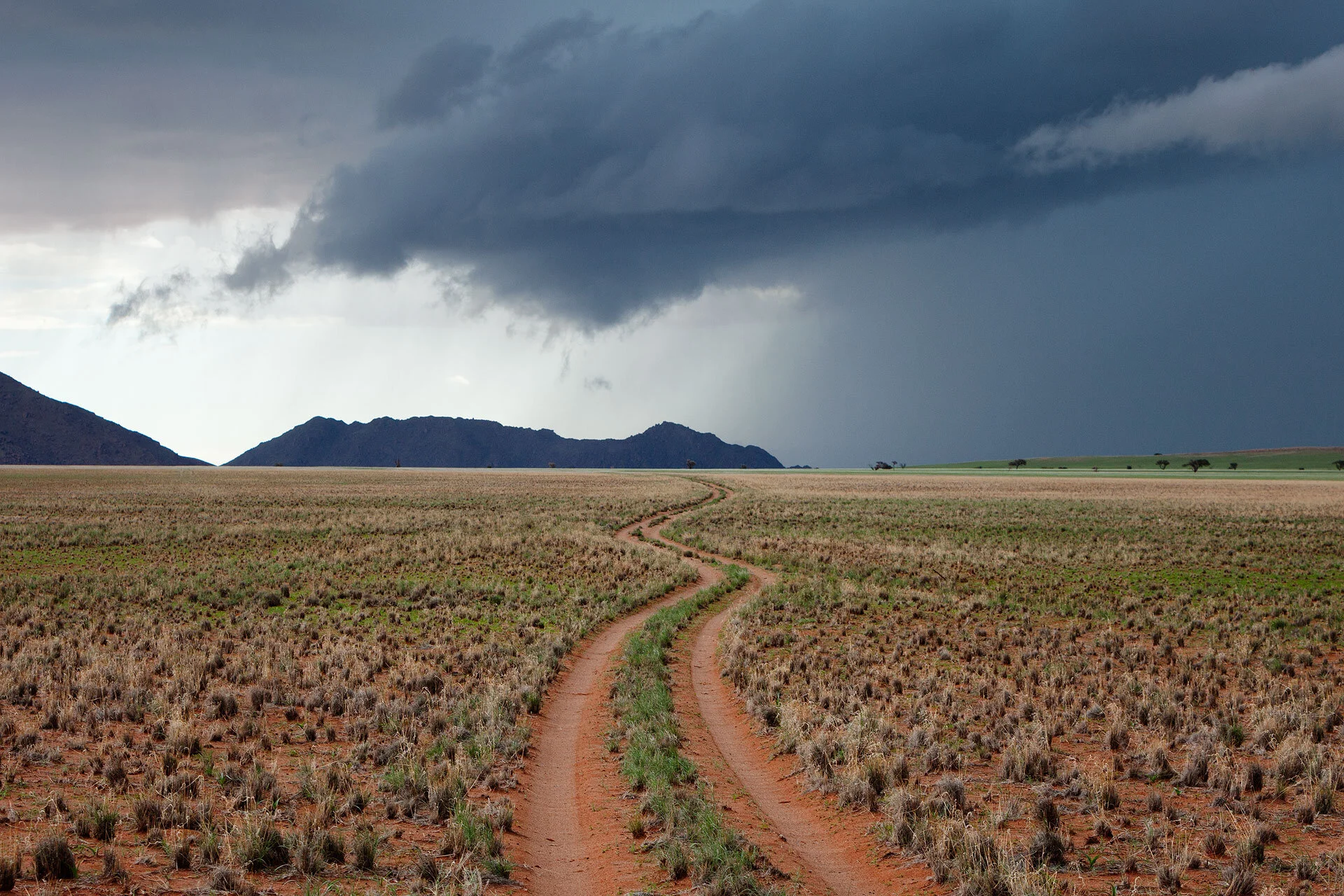A cloudburst from a supercell thunderstorm over the Namib Rand. February 2011.
Namibia in Flood
Nowhere on earth is the effect of water more incredible than where it is needed the most. When it comes to the building blocks of fauna and flora, the Namib has almost everything in extreme abundance – fertile soils rich in minerals from an ancient crumbling landscape, open space like few other parts of the world and unobstructed energy radiating down from the sun at least 300 days of the year. The only thing that is missing is water.
In 2011, Namibia’s stars aligned and the rare weather systems that suck moisture down from the tropics set in over the desert for nearly 3 months. These weather anomalies usually only occur once or twice in a good rain year and only last 2/3 days. I recall every single day being a storm chase – watching mint-green curtains of torrential rain march from the east with a milky gray shelf cloud in front. Lightning assaulted the iron-rich dolerite ridges of the Namib Rand, while herds of Oryx, sometimes 500 strong, did their best to outrun the storms, all in vain. Rainbows were guaranteed every single day and the night skies appeared every evening above flickering purple displays of lighting in every direction.
Nearly a decade has passed and as murphy would have it, the wettest year in a century was followed by the driest cycle in recorded history. 2014-2017 did not provide much photographic opportunity, but it provided the contrast to show just how special 2011 was. The most striking contrast between the dry and the wet years was in the late mornings; in a dry year, the desert seems to adhere to its common reputation of being relatively lifeless (compared to e.g. tropical environments). What little life there is, is clearly noticeable amongst the static environment and silence of nothing but sand and rock. When a bird flies up, you notice it, when a ground squirrel peeks out of its burrow, it catches your eye and you can see Jackals on their mischievous trot from kilometres away. The resilient desert wildlife going about everyday life, but the moments in-between feature a silence that is almost ominous. As if the entire environment is in hibernation, awaiting the rain.
In the years of abundant rainfall, nothing is static and it is never quiet. The earth seems to emanate a harmonious vibration that has an incredible presence and aura. In reality, it is the hibernating desert that has come to life in the presence of water – nature’s reproductive drive in highest gear.
As a landscape photographer, my favourite element is of course the grass. In abundant years, the otherwise lifeless sand brings forth fields of grass comparable to humanity’s greatest grain production regions like Palouse and Tuscany. The grass kickstarts a once-in-a-generation explosion in the herbivore chain and that ripples onto the Namib desert’s carnivorous species. Amongst the grass lives billions of insects, reptiles and invertebrates – producing that energetic hum typical of savannah ecosystems. Countless animals like mice, squirrels, jackal, hares, Aardwolf and Cape fox feast on all the food and smaller critters in the grass, but you’ll never see them in years like 2011, when the grass stands taller than they do. Grazing on the abundant grass, herds of Oryx and Springbok thrive on Namibia’s grassy plains in years like these, with herds several thousand strong concentrating in the valleys that got the best rain. No doubt keeping an eye from the mountains, leopard and cheetah await the easy pickings that come from the massive populations of antelope. Swooping, swerving and gliding amongst it all is the diverse desert birdlife. From the smallest like the dune lark, to the high altitude thermal surfers like the lappet face vulture. At night, amongst the purple flicker of the lightning, the owls get to binge on the abundance of mice in the grass.
All together, the desert buzzes with a seemingly nuclear energy when there is water in abundance. It may hum a slightly different tune at night, but that same relentless energy is there, not all of it always so pleasant.
Photographically, the grass simplifies the landscape in the same way that snow does – it covers what is normally a random mess of rocks, sand and shrubs with a perfectly uniform carpet of glistening grass. This works wonders for photos, but it goes beyond that. For me, those carpets of grass represent the incredible explosions of the desert life. Sunsets amongst those fields of grass, with abundant wildlife roaming all around is what stimulates that epitomised feeling of Africa that keeps tourists coming back for the rest of their lives. Perhaps it stirs our ancient instincts that tell us such years will be prolific for a specific omnivore (homo sapiens). What I do know for sure is that the floods of 2011 were without a doubt the most special experience of my photographic career and because of it, I will obsess over Namibia’s rainfall for the rest of my life, hoping for a repeat.






































